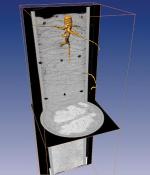X-ray vision goes underground
 Earth Science Earth Science
A team from Waite Campus is working on a revolutionary technique using X-rays to help understand the effects of salinity and soil characteristics on the root structure of plants. Dr Rob Davidson and Dr Ann McNeill of the University of Adelaide's School of Earth and Environmental Sciences said using X-rays allows them to examine root systems without having to dig them up, which often destroys the plant under study. "This technique will allow us to see how native plants in areas with high levels of salinity are interacting with a hostile environment. We are assuming they have various mechanisms that counter the salinity levels, and if we are able to see how these work, we can apply them to agricultural crops," Dr Davidson said. "There are hostile subsoils in 50% of the southern agricultural region and the methodology we have developed at Waite allows us to look at the way chemicals in soil impair root growth. Clearly, being better able to identify the root issues, and then use this information to correct them, will have a large impact for the agricultural community. "One of the problems up until now has been that, in order to understand what is going on with the root systems of plants, you actually have to destroy the root architecture in order to examine it. It has also been a very time consuming process. "Our technique is unique in that we remove an intact core, then grow plants in it and then X-ray the soil core so we can see the way the root has grown in relation to the soil characteristics throughout the strata. The X-ray gives us 1200 slices through a 50cm high, 15cm core. "One existing technique involves physically making slices to examine changes in root density with depth. "This is much, much easier than the existing techniques. The old ones don't compare." After this stage, the process reverts to traditional techniques where more detailed information on small roots in relation to the attributes of soil is required. The project has received $400,000 from the Federal Department of Education, Science and Training and $49,000 internal University funding during the past three years. Story by Lisa Reid
|





